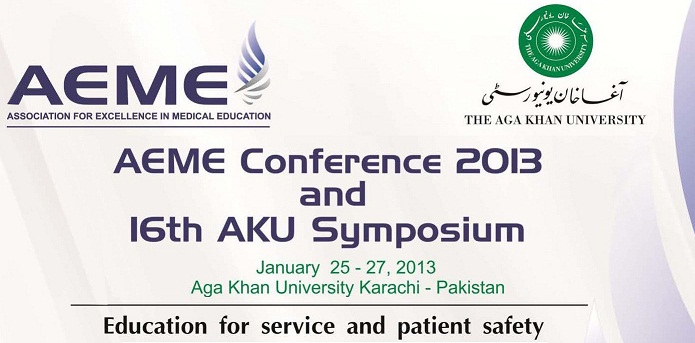Day 2 : Poster Presentations (Theme: Evaluation & Assessment)
Shrinking distances and broadening horizons via teleradiology: a success story of reaching out to under-privileged using innovative technology in third world
Location
Auditorium Pond Side
Start Date
27-1-2013 8:30 AM
Abstract
Background: Tele-Radiology has opened new avenues to enhance the domain of service and impart quality service to remote areas where there is lack of expertise and resources. The objective of this study is to analyze the impact of Tele-Radiology on the healthcare delivery of remote area hospital in Afghanistan in terms of reporting of specialized procedures of CT Scan (Computed Tomography) and MRI (Magnetic Resonance Imaging).
Methods: In line with the institution’s mission to provide accessibility and continue to innovate the Radiology department of The Aga Khan University Hospital (AKUH) in Karachi, Pakistan took the initiative of extending radiological examinations’ reporting of CT Scan and MRI to French Medical Institute for Children (FMIC) in Kabul, Afghanistan. Along with online reporting, we also used technology in building capacity via video-conferencing, e-learning, online education sessions as well as hiring interviews and executive meetings. To analyze the impact, it was necessary to collect the data from both the service providers; management of FMIC was requested to share the total number and types of procedures carried out by them from 2008 till 2011. From our AKUH set up we acquired the data from 2008 regarding the number of CT & MRI procedures being reported by credentialed radiologists. Analysis of annual data was carried out to determine the trend in terms of volume and type of procedures and services. In the initial phase online reporting service started with CT scan only and subsequently MRI reporting was also added.
Results: Based on the retrospective data analysis, it was observed that FMIC usually sends selected (complex) CT and MRI studies requiring expertise that is currently not available with them. Over the period of four years almost 650 CT scan cases were referred for reporting online, which makes an average of 165 cases per year. Similarly for MRI, in the first two years’ time almost 400 cases have been referred for reporting. Additionally, significant amount of financial and human resources have been saved/optimized by conducting online continuous medical education sessions and interviews for hiring of professional. Cross functional trainings are also imparted and operational oversight is done via video-conferencing.
Conclusions: It is heartening to note that the development made in medical technology and its benefits are made accessible to one of the most under-privileged society via Tele-radiology.
Key words: shrinking distances, Tele-Radiology, e-learning
Shrinking distances and broadening horizons via teleradiology: a success story of reaching out to under-privileged using innovative technology in third world
Auditorium Pond Side
Background: Tele-Radiology has opened new avenues to enhance the domain of service and impart quality service to remote areas where there is lack of expertise and resources. The objective of this study is to analyze the impact of Tele-Radiology on the healthcare delivery of remote area hospital in Afghanistan in terms of reporting of specialized procedures of CT Scan (Computed Tomography) and MRI (Magnetic Resonance Imaging).
Methods: In line with the institution’s mission to provide accessibility and continue to innovate the Radiology department of The Aga Khan University Hospital (AKUH) in Karachi, Pakistan took the initiative of extending radiological examinations’ reporting of CT Scan and MRI to French Medical Institute for Children (FMIC) in Kabul, Afghanistan. Along with online reporting, we also used technology in building capacity via video-conferencing, e-learning, online education sessions as well as hiring interviews and executive meetings. To analyze the impact, it was necessary to collect the data from both the service providers; management of FMIC was requested to share the total number and types of procedures carried out by them from 2008 till 2011. From our AKUH set up we acquired the data from 2008 regarding the number of CT & MRI procedures being reported by credentialed radiologists. Analysis of annual data was carried out to determine the trend in terms of volume and type of procedures and services. In the initial phase online reporting service started with CT scan only and subsequently MRI reporting was also added.
Results: Based on the retrospective data analysis, it was observed that FMIC usually sends selected (complex) CT and MRI studies requiring expertise that is currently not available with them. Over the period of four years almost 650 CT scan cases were referred for reporting online, which makes an average of 165 cases per year. Similarly for MRI, in the first two years’ time almost 400 cases have been referred for reporting. Additionally, significant amount of financial and human resources have been saved/optimized by conducting online continuous medical education sessions and interviews for hiring of professional. Cross functional trainings are also imparted and operational oversight is done via video-conferencing.
Conclusions: It is heartening to note that the development made in medical technology and its benefits are made accessible to one of the most under-privileged society via Tele-radiology.
Key words: shrinking distances, Tele-Radiology, e-learning

